- Transformation
- 20 min read
- March 2025
Types of Chatbots - Which One Is Right for Your Business
Key Takeaways
The modern business landscape is undergoing a digital shift, where automation and artificial intelligence (AI) are no longer optional but essential for maintaining competitive advantage.
One of the most impactful digital tools businesses are leveraging today is chatbots—AI-powered virtual assistants that streamline operations, enhance customer experiences, and improve efficiency.
For companies operating in Retail, Manufacturing, Distribution, and eCommerce, chatbots have moved beyond simple scripted responses.
They now play a pivotal role in automating customer interactions, sales processes, operational workflows, and even predictive maintenance.
But with different chatbot types available, business leaders must determine which one aligns best with their operational needs and digital strategy.
A chatbot that works for an eCommerce brand handling thousands of customer inquiries daily may not be suitable for a manufacturer looking to optimize production line efficiency.
Similarly, a logistics company needing real-time shipment updates will require a different chatbot solution than a retail business automating in-store support.
This article provides an in-depth look into different types of chatbots, their strategic applications across industries, and how decision-makers can leverage them for business transformation.
By the end, you’ll have a clear understanding of which chatbot aligns best with your business goals.
Understanding the different types of chatbots and their business applications
Businesses today are integrating chatbots not just for customer service but for sales, operations, logistics, and workforce automation. However, not all chatbots function the same way.
Choosing the right one depends on the complexity of tasks, level of intelligence required, and industry-specific needs.
Here’s a breakdown of the primary types of chatbots and their best-fit applications in retail, manufacturing, distribution, and eCommerce.
1. Rule-based chatbots (decision-tree chatbots)

Rule-based chatbots operate on predefined workflows. They follow a structured decision tree, responding based on pre-programmed rules and keyword recognition. These chatbots are highly effective for handling predictable queries, automating FAQs, and providing scripted responses.
Best for:
- Customer support automation: Handling frequently asked questions, return policies, and store inquiries.
- Order tracking and status updates: Providing real-time updates to customers on purchases and deliveries.
- Employee self-service portals: Answering HR, IT, and administrative queries.
Industry applications:
- Retail: A supermarket chain implements a rule-based chatbot to handle product availability inquiries and store locations.
- Distribution: A logistics provider uses a chatbot to automate customer queries about shipment status.
- Manufacturing: A factory’s HR department deploys a chatbot for automating leave requests and payroll-related questions.
Rule-based chatbots work well when the scope of interactions is clear and repetitive. However, they fall short in handling complex, ambiguous, or evolving customer needs, which is where AI-powered chatbots come in.
2. AI-powered chatbots (conversational and NLP-driven)
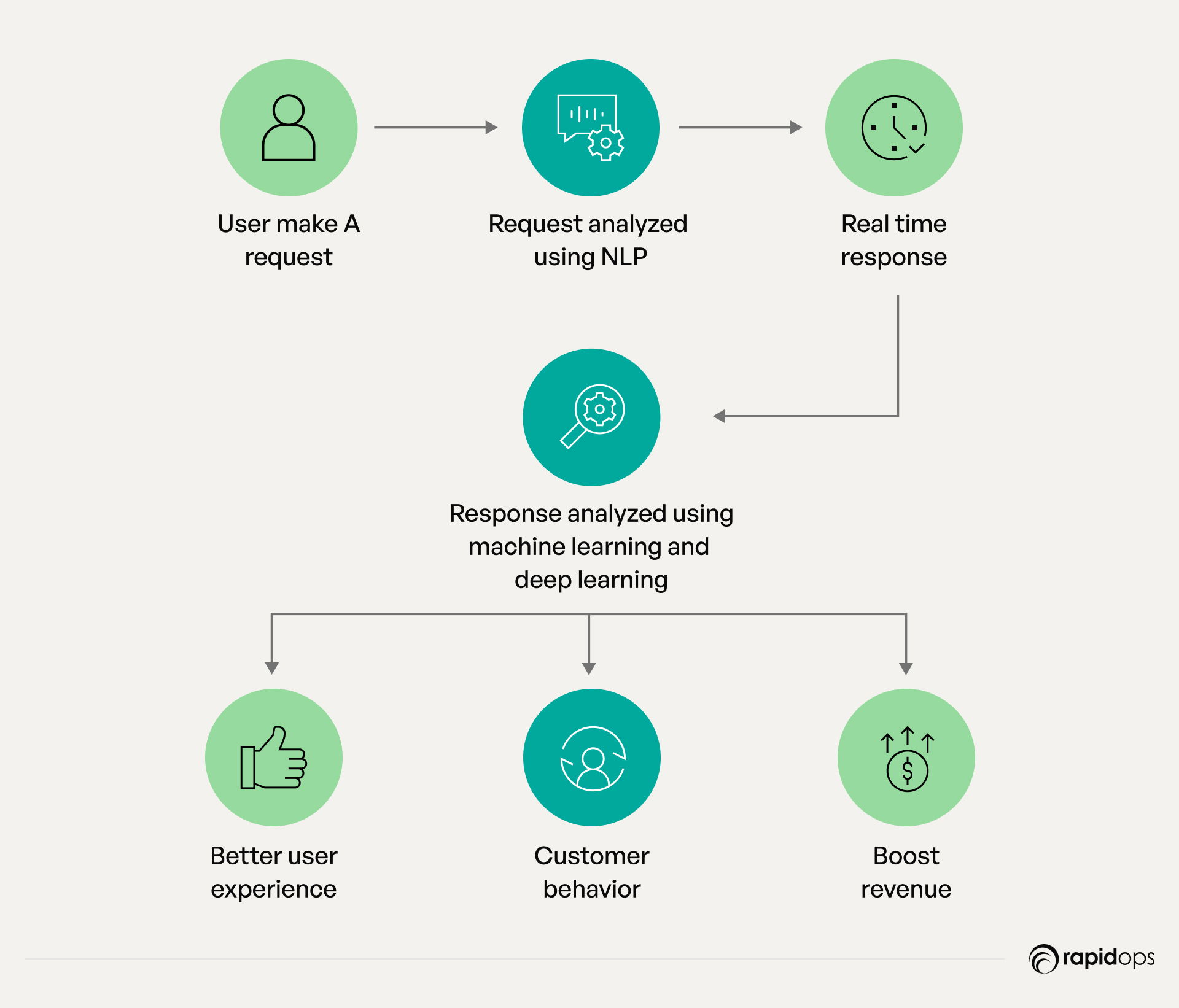
Unlike rule-based chatbots, AI-powered chatbots use machine learning (ML) and natural language processing (NLP) to interpret and respond to user intent dynamically. They can understand context, learn from interactions, and improve over time, making them ideal for handling personalized customer experiences and complex queries.
Best for:
- Personalized customer engagement: Offering product recommendations, upselling, and assisting in buying decisions.
- Complex query resolution: Answering non-standard inquiries by understanding customer intent rather than matching keywords.
- Predictive assistance: Learning from customer behavior to provide proactive suggestions.
Industry applications:
- eCommerce: A fashion retailer integrates an AI chatbot that provides personalized outfit recommendations based on previous purchases and browsing behavior.
- Retail: A customer support chatbot for an electronics brand analyzes customer complaints and suggests troubleshooting steps before escalating to human agents.
- Manufacturing: An AI chatbot assists in predictive maintenance, notifying engineers when machine performance metrics indicate an impending failure.
AI-powered chatbots enhance customer experience through personalization and deep learning. However, some businesses require a blend of structured rule-based interactions and AI-driven adaptability—this is where hybrid chatbots come into play.
3. Hybrid chatbots (combination of AI and rule-based systems)
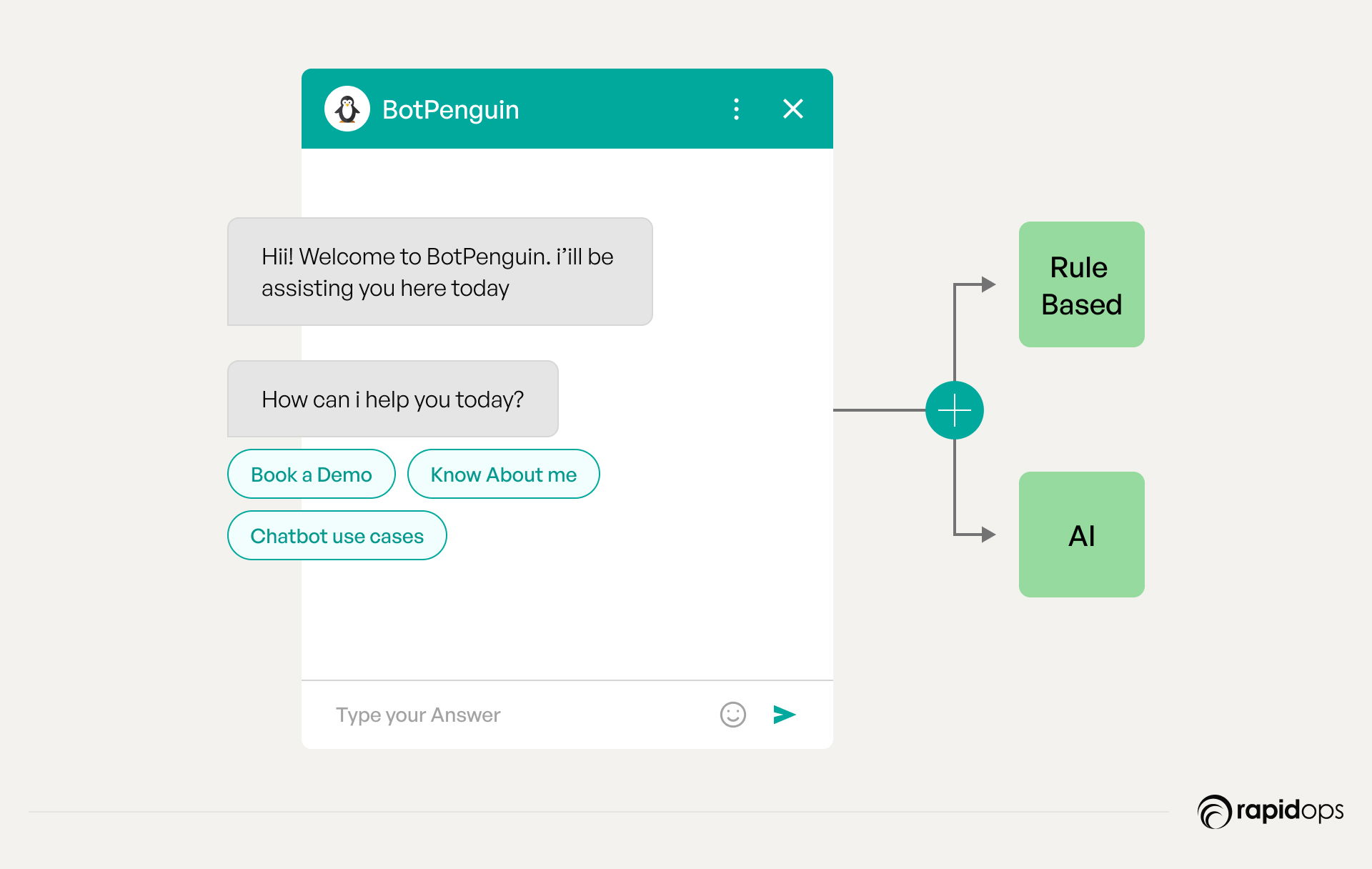
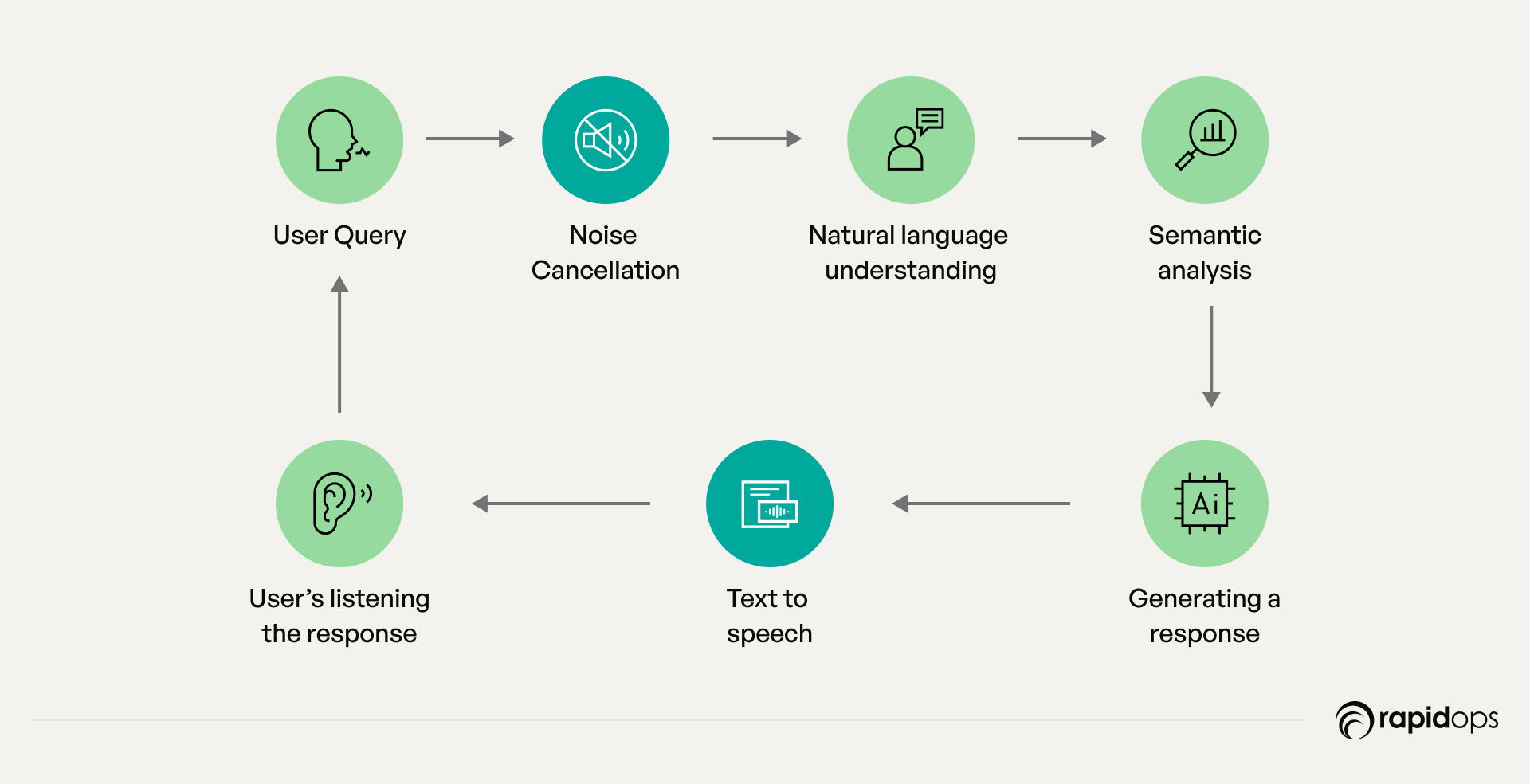
Hybrid chatbots combine the efficiency of rule-based chatbots with the intelligence of AI-powered bots. They follow predefined workflows for structured tasks while also leveraging NLP and AI for context-driven responses when needed.
Best for:
- Multi-layered customer service: Handling simple queries automatically while escalating complex issues to AI or human agents.
- Sales and lead qualification: Automating basic lead screening while allowing AI to handle deeper sales conversations.
- Operational automation: Streamlining workflows by blending automated responses with intelligent decision-making.
Industry applications:
- Retail: A global cosmetics brand integrates a hybrid chatbot where routine product inquiries follow predefined scripts, but complex skin care questions get AI-driven personalized responses.
- eCommerce: An online marketplace deploys a chatbot that automatically processes returns using predefined rules but engages AI to handle refund disputes intelligently.
- Manufacturing: A chatbot for supply chain coordination automates order updates while AI-powered assistance predicts delivery delays and suggests alternatives.
Hybrid chatbots provide a scalable solution for businesses needing automation without sacrificing flexibility. However, for businesses prioritizing convenience and accessibility, voice-enabled chatbots are becoming a game-changer.
4. Voice-enabled chatbots (AI assistants with voice interaction)
Voice-enabled chatbots process spoken language rather than text-based inputs. These bots leverage speech recognition technology and AI to assist users through hands-free interactions.
Best for:
- Voice commerce and shopping assistance: Enabling customers to browse, select, and purchase products through voice commands.
- Logistics and fleet management: Providing real-time shipment updates via hands-free communication.
- Operational guidance: Assisting factory workers with machine instructions, reducing the need for manual inputs.
Industry applications:
- Retail: A large grocery chain implements a voice-enabled chatbot that lets customers add items to their shopping list using voice commands via a mobile app.
- Distribution: A logistics company equips truck drivers with a voice-enabled assistant for route navigation and real-time delivery updates.
- Manufacturing: A plant integrates a voice-activated assistant that guides technicians through complex repair procedures hands-free.
Voice-enabled chatbots are revolutionizing accessibility and convenience, particularly for industries where hands-free operations are critical.
Bringing it all together: Matching chatbot types to industry needs
Each chatbot type serves a unique business purpose. The key to maximizing chatbot efficiency is aligning their capabilities with industry-specific use cases and business objectives.
|
Business Need |
Recommended Chatbot Type |
Industry Fit |
|
Automate customer support |
Rule-based chatbot |
Retail, eCommerce, Distribution |
|
Handle complex customer queries |
AI-powered chatbot |
eCommerce, Retail |
|
Improve operational efficiency |
Hybrid chatbot |
Manufacturing, Logistics |
|
Enhance accessibility with voice commands |
Voice-enabled chatbot |
Retail, Distribution, Logistics |
Selecting the right chatbot is all about its business impact.
Industry-specific chatbot use cases for key decision-makers
For decision-makers in retail, manufacturing, distribution, and eCommerce, adopting chatbots is not just about automation—it’s about optimizing business functions to drive growth, reduce costs, and improve customer engagement. This section explores how different types of chatbots solve real-world business challenges in these industries.
1. Retail: Enhancing customer engagement and sales conversion
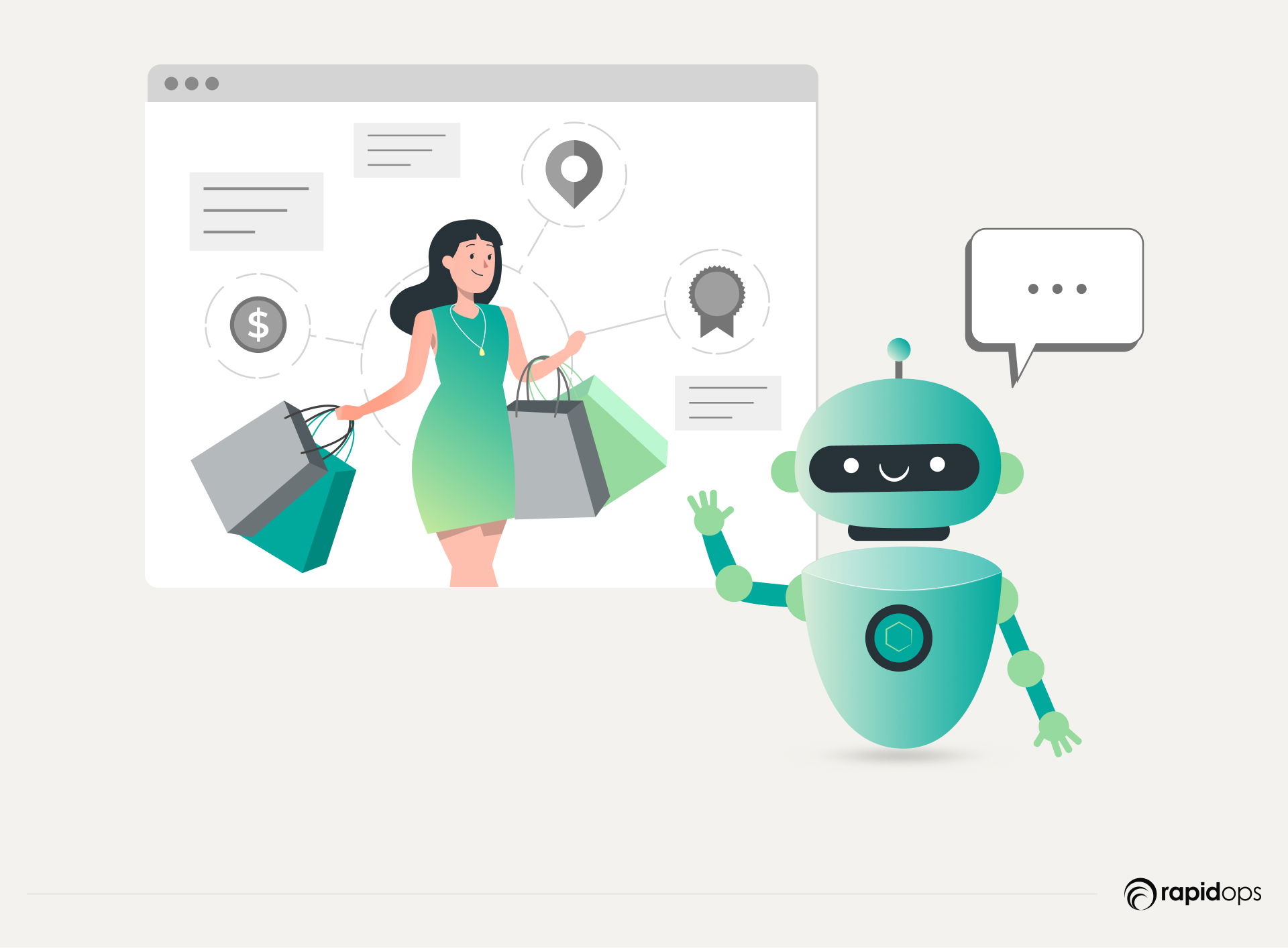
Retailers today face rising customer expectations for instant service, personalized recommendations, and seamless shopping experiences. Chatbots bridge the gap by providing real-time support, product guidance, and sales assistance.
Use cases in retail
1. AI-powered chatbots for personalized shopping assistance
Chatbots analyze customer browsing behavior, past purchases, and preferences to provide tailored product recommendations.
Example: A global apparel brand deploys an AI chatbot on its website and mobile app, suggesting outfits based on a customer’s style preferences and guiding them through the purchase process.
2. Hybrid chatbots for multi-channel customer support
Retail brands operate across multiple channels—websites, mobile apps, and social media. Hybrid chatbots unify customer support by handling FAQs automatically while escalating complex issues to human agents.
Example: A home appliance retailer integrates a chatbot across its website, WhatsApp, and Facebook Messenger, ensuring consistent support across all touchpoints.
3. Rule-based chatbots for loyalty programs and store inquiries
Retailers use chatbots to automate loyalty program management, offering customers details on points, discounts, and exclusive deals.
Example: A supermarket chain deploys a chatbot that allows customers to check their loyalty points balance and redeem rewards via text-based interactions.
By integrating chatbots into retail operations, businesses reduce wait times, increase customer satisfaction, and drive higher conversions—a competitive advantage in today’s digital-first retail landscape.
2. Manufacturing: Optimizing operational efficiency and workforce automation

Manufacturers operate in highly structured environments where efficiency, accuracy, and predictive maintenance are critical. Chatbots assist by automating routine queries, reducing downtime, and improving workforce productivity.
Use cases in manufacturing
1. AI-powered chatbots for predictive maintenance
Manufacturing plants rely on predictive analytics to prevent machine failures before they occur. AI chatbots integrate with IoT sensors to monitor equipment performance and alert teams when maintenance is required.
Example: A car manufacturer uses an AI chatbot that monitors machinery performance and alerts engineers about potential malfunctions based on sensor data.
2. Rule-based chatbots for HR and employee training
Manufacturing companies automate workforce queries related to payroll, leave requests, compliance training, and safety protocols using chatbots.
Example: A steel production company deploys a chatbot for employee onboarding, guiding new hires through training modules and company policies.
3. Hybrid chatbots for supply chain coordination
Manufacturers work with multiple vendors and suppliers, requiring real-time updates on raw material deliveries and production schedules. Hybrid chatbots streamline order tracking, supplier communication, and logistics management.
Example: A furniture manufacturer integrates a chatbot to provide real-time status updates on raw material shipments and expected delivery timelines.
By implementing chatbots in manufacturing, businesses reduce downtime, enhance workforce productivity, and optimize supply chain visibility.
3. Distribution & logistics: Streamlining supply chain management
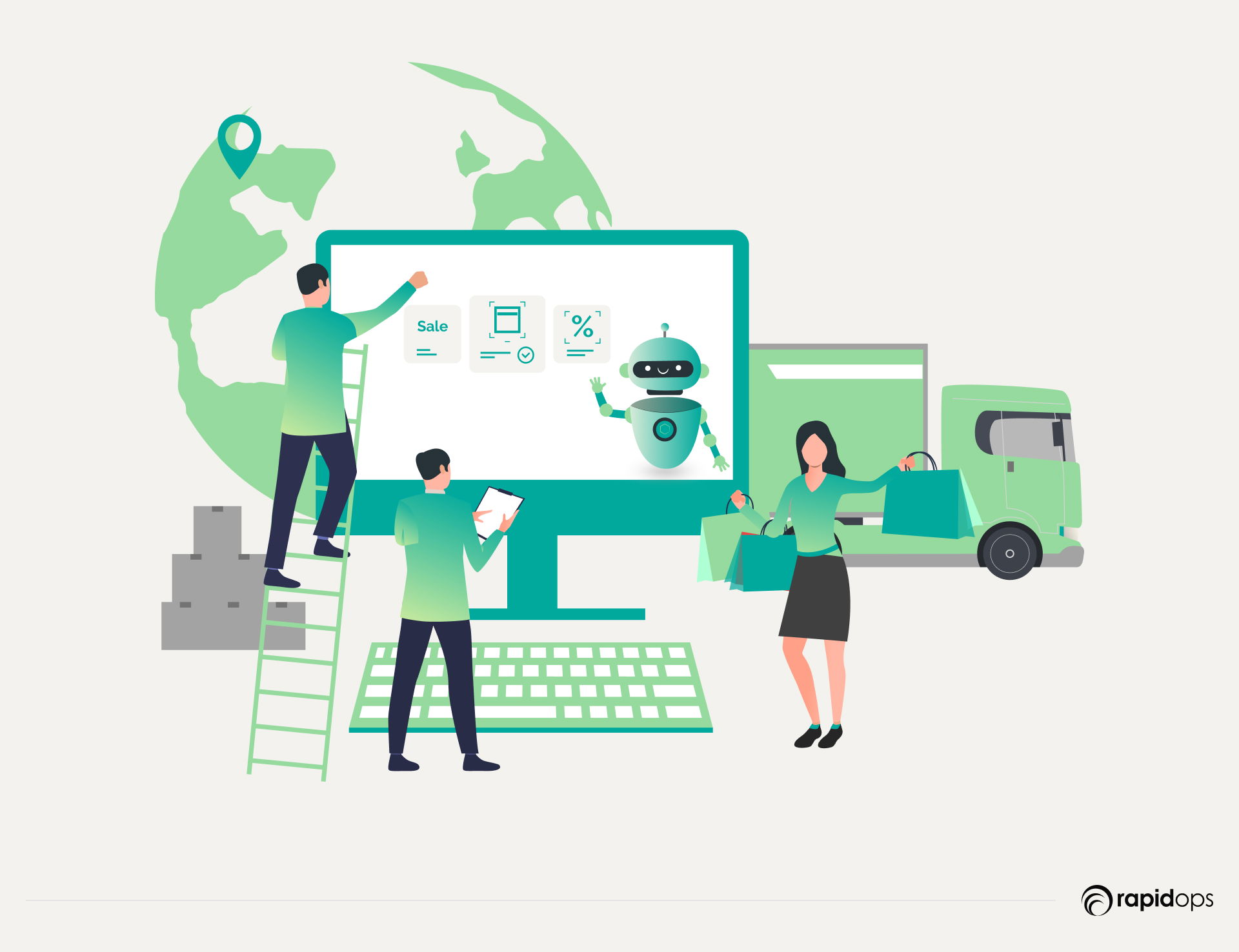
In distribution and logistics, timely information flow is critical to reducing delays, optimizing fleet operations, and ensuring accurate inventory management. Chatbots play a pivotal role in automating shipment tracking, warehouse management, and delivery coordination.
Use cases in distribution and logistics
1. AI-powered chatbots for real-time shipment tracking
Logistics firms use AI-powered chatbots to provide automated shipment tracking updates, reducing dependency on human agents.
Example: A global shipping company deploys an AI chatbot that tracks shipments in real-time and provides customers with estimated delivery times based on live GPS data.
2. Voice-enabled chatbots for fleet and driver assistance
Logistics providers leverage voice assistants to help drivers navigate routes, report incidents, and check fuel efficiency.
Example: A trucking company integrates a voice chatbot for hands-free route guidance and delivery status updates, allowing drivers to operate safely without manual inputs.
3. Rule-based chatbots for warehouse and inventory management
Distribution centers use chatbots to automate warehouse inquiries, stock level updates, and reorder notifications.
Example: A wholesale distributor implements a chatbot that automatically alerts warehouse managers when stock levels for critical items drop below a set threshold.
Chatbots in distribution and logistics reduce manual workload, improve delivery efficiency, and enhance operational oversight, ensuring that businesses can meet demand with precision.
4. eCommerce: Automating customer interactions and driving sales growth
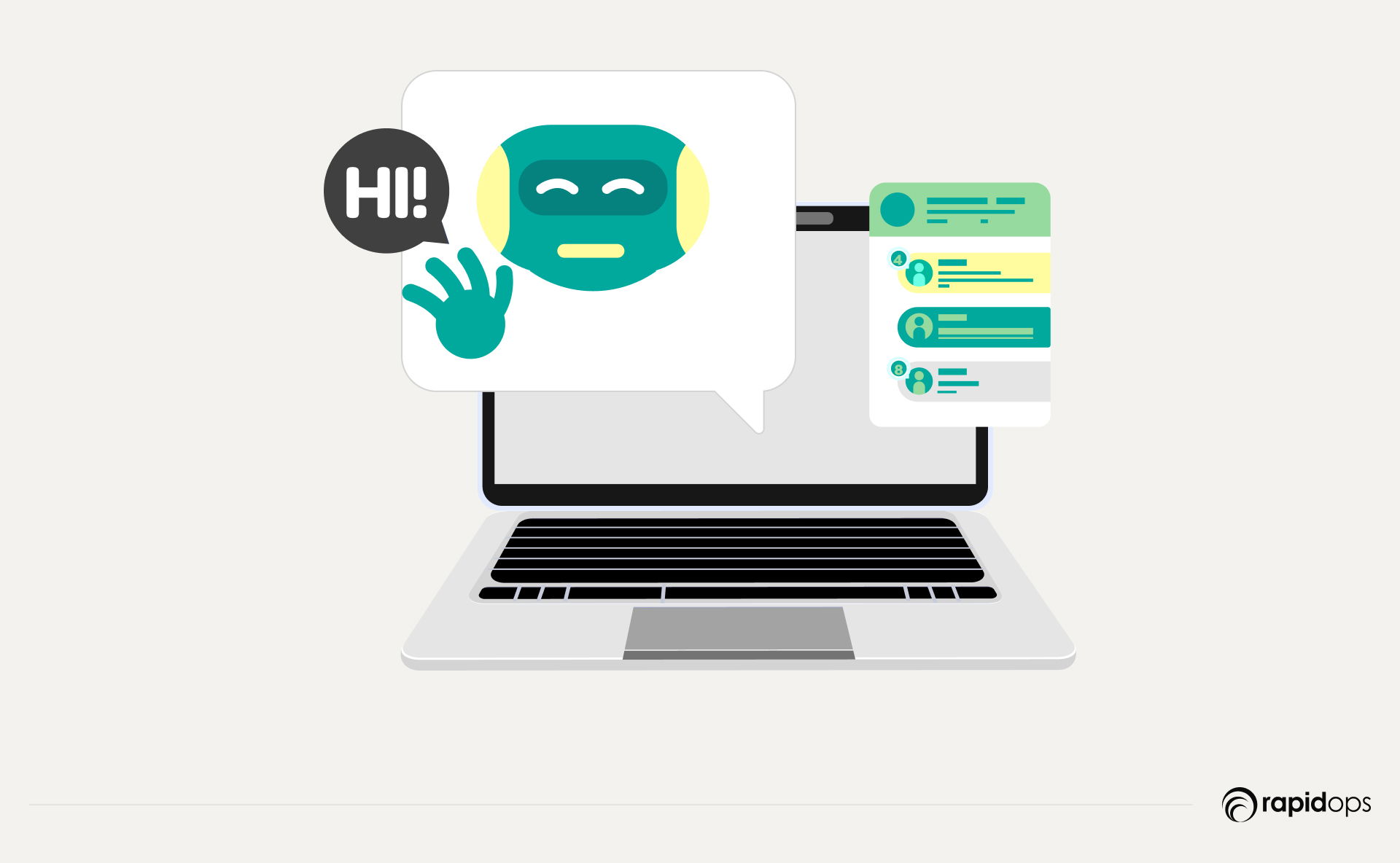
In eCommerce, success hinges on personalized customer experiences, real-time engagement, and seamless order processing. Chatbots act as digital sales assistants, ensuring that customers receive instant support, recommendations, and purchase guidance.
Use cases in eCommerce
1. AI-powered chatbots for abandoned cart recovery
eCommerce businesses lose millions in revenue due to abandoned carts. AI chatbots analyze user behavior and re-engage potential buyers through personalized follow-ups.
Example: An online electronics retailer deploys an AI chatbot that sends automated reminders with discount offers to users who leave items in their cart without completing the purchase.
2. Hybrid chatbots for live sales assistance
Customers often have pre-purchase concerns, requiring instant responses to product-related queries. Hybrid chatbots provide basic product information and escalate complex concerns to live agents when necessary.
Example: A luxury watch brand uses a chatbot to guide high-value customers through product specifications and financing options before connecting them with a sales consultant.
3. Voice-enabled chatbots for voice commerce
As voice commerce gains traction, businesses integrate voice-enabled chatbots for hands-free shopping experiences.
Example: A consumer electronics brand develops a voice chatbot that allows customers to place orders through voice commands via a smart home assistant.
By leveraging chatbots in eCommerce, brands increase conversion rates, reduce cart abandonment, and deliver personalized shopping experiences at scale.
Driving business transformation with the right chatbot strategy
Chatbots are strategic enablers for businesses aiming to scale operations, optimize resources, and deliver seamless customer experiences.
|
Industry |
Key chatbot benefit |
Business impact |
|
Retail |
Personalized shopping assistance |
Higher sales conversions & customer engagement |
|
Manufacturing |
Predictive maintenance |
Reduced downtime & operational costs |
|
Distribution & logistics |
Shipment tracking automation |
Faster deliveries & improved supply chain visibility |
|
eCommerce |
Abandoned cart recovery |
Increased revenue & customer retention |
The key for decision-makers is to align chatbot capabilities with specific business objectives. The next section explores why leaders need to prioritize chatbot adoption for long-term digital transformation.
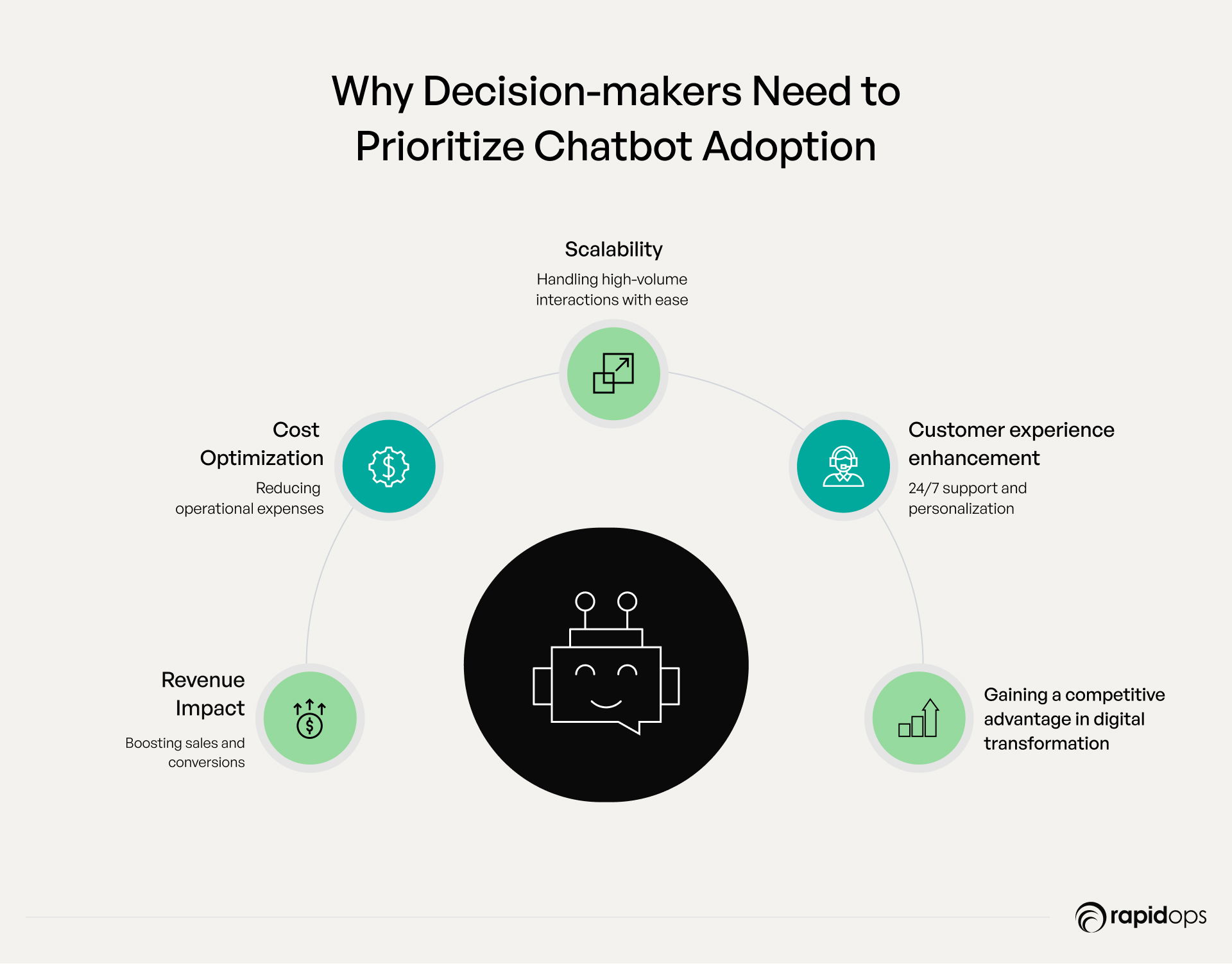 need to prioritize chatbot adoption
need to prioritize chatbot adoption
The business landscape is evolving rapidly, with automation and AI-driven solutions becoming essential for scalability and efficiency. For decision-makers in retail, manufacturing, distribution, and eCommerce, chatbot adoption is not just about improving customer interactions—it’s about driving measurable business outcomes.
Ignoring chatbot integration today means losing competitive advantage, as competitors continue to optimize their processes through AI and automation. This section breaks down the core reasons why leaders must prioritize chatbots as a key element of their digital transformation strategy.
1. Revenue impact: Boosting sales and conversions
Chatbots are proven revenue accelerators, driving higher conversion rates through real-time engagement, sales assistance, and predictive recommendations.
Retail & eCommerce: AI chatbots improve customer retention by personalizing product recommendations, offering discounts, and guiding users through purchase decisions.
Example: A global fashion retailer saw a 15% increase in sales after deploying an AI chatbot that assisted customers with outfit pairings based on previous purchases.
Manufacturing & Distribution: Chatbots streamline B2B sales processes, enabling automated order inquiries and supplier interactions.
Example: A leading industrial supplier used a chatbot to automate bulk order processing, reducing manual sales rep intervention and accelerating deal closures.
For decision-makers, chatbots are not just cost-saving tools—they are revenue generators, ensuring that every customer interaction contributes to sales growth.
2. Cost optimization: Reducing operational expenses
One of the biggest challenges businesses face is balancing operational efficiency with customer expectations. Traditional support teams require large workforces to handle queries, while chatbot automation can cut costs significantly without compromising service quality.
Retail & eCommerce: Chatbots replace the need for round-the-clock customer service teams by handling FAQs, order tracking, and refunds.
Example: A consumer electronics brand reduced customer service costs by 40% by shifting 70% of inquiries to chatbots.
Manufacturing & Logistics: AI chatbots assist in inventory management, fleet coordination, and supplier communication, reducing administrative overhead.
Example: A logistics firm cut response times by 60% by implementing chatbots to handle customer shipment queries.
By automating repetitive tasks, businesses reduce labor costs, optimize workforce efficiency, and allow employees to focus on higher-value tasks.
3. Scalability: Handling high-volume interactions with ease
As businesses grow, so does the demand for faster, more efficient customer service and operational workflows. Scaling traditional human-driven support models is expensive, while chatbots enable limitless scalability at minimal cost.
Retail & eCommerce: Chatbots handle thousands of customer queries simultaneously, ensuring smooth customer engagement during high-traffic periods (e.g., Black Friday sales).
Example: An online marketplace scaled customer service operations by 5x without increasing headcount by integrating AI-powered chatbots.
Manufacturing & Distribution: Chatbots manage supplier queries, track inventory, and process orders at scale.
Example: A global supplier automated 80% of vendor inquiries through a chatbot, freeing up procurement teams for strategic sourcing.
For businesses looking to expand, chatbots provide an agile, scalable solution that grows with demand, without proportionally increasing costs.
4. Customer experience enhancement: 24/7 support and personalization
Today’s consumers expect instant responses, personalized interactions, and seamless service experiences. Chatbots enable businesses to deliver on these expectations without delay.
Retail & eCommerce: AI-driven chatbots analyze customer purchase behavior to provide tailored product recommendations and real-time support.
Example: A beauty retailer implemented a chatbot that provided personalized skincare suggestions based on customer preferences, boosting engagement rates by 35%.
Manufacturing & Distribution: Chatbots assist with B2B order processing, invoice tracking, and supplier communication, reducing response times and enhancing service reliability.
Example: A wholesale distributor leveraged chatbots to automate purchase order tracking, cutting customer response times by 50%.
By enhancing customer experience, chatbots increase satisfaction, build brand loyalty, and improve retention rates, directly impacting long-term business growth.
Gaining a competitive advantage in digital transformation
As businesses undergo digital transformation, leaders who fail to adopt AI-powered solutions risk falling behind. Chatbots provide a technological edge, ensuring that businesses operate smarter, faster, and more efficiently.
|
Business Priority |
Chatbot Benefit |
Impact |
|
Increase sales |
AI-driven product recommendations |
Higher revenue |
|
Reduce costs |
Automated customer support |
Lower operational expenses |
|
Scale operations |
Chatbots handling high-volume inquiries |
Improved efficiency |
|
Enhance customer experience |
Personalized and real-time responses |
Better retention and brand loyalty |
Chatbots are no longer a "nice-to-have"—they are a business necessity for organizations aiming to stay competitive.
Developing or selecting the right chatbot for your business
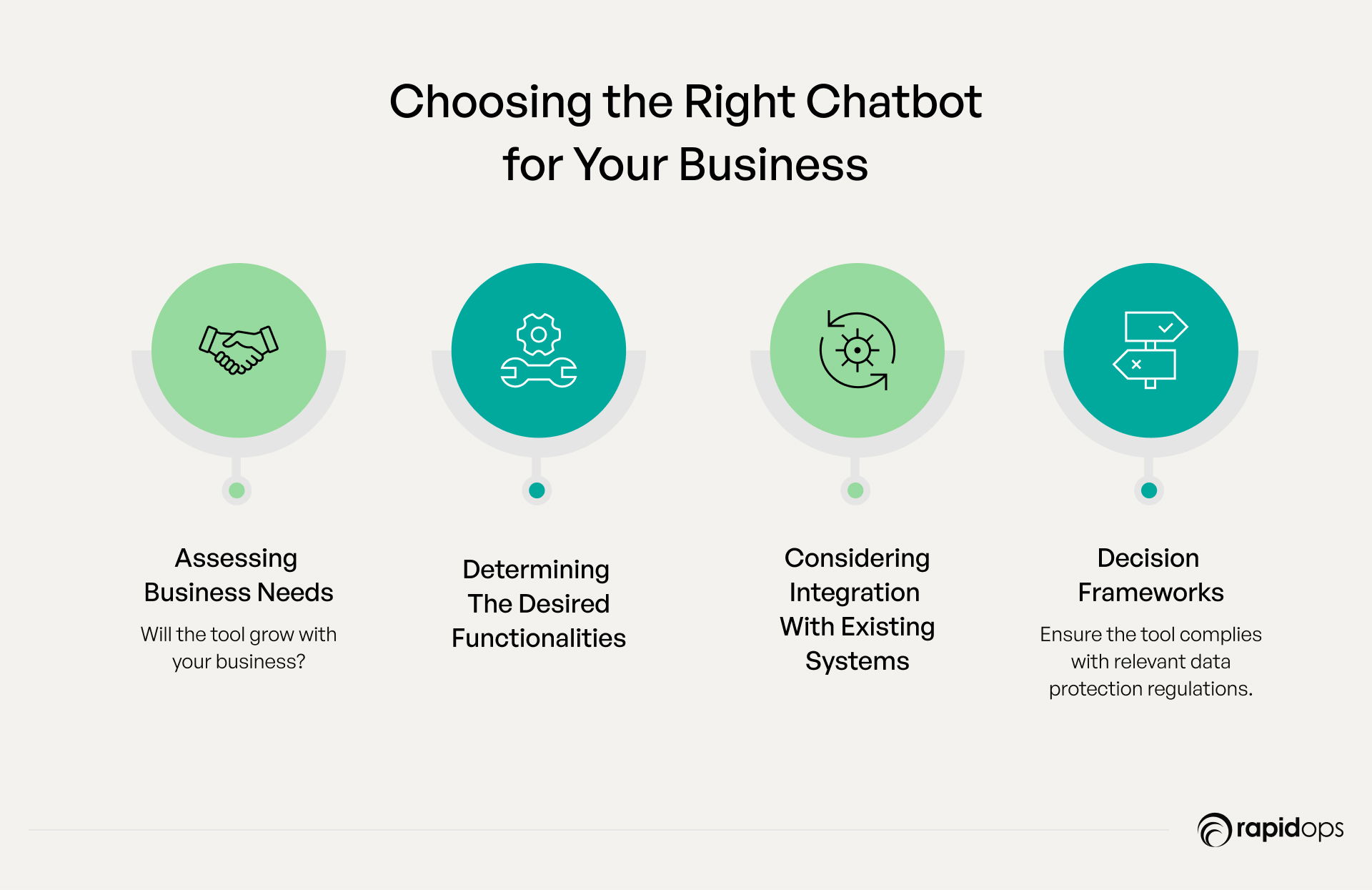
The success of chatbot implementation depends on choosing the right type of chatbot that aligns with business objectives, industry needs, and customer expectations. A one-size-fits-all approach does not apply—businesses must assess specific pain points, operational goals, and scalability requirements before deciding on a chatbot solution.
This section outlines the key considerations for decision-makers when selecting a chatbot that delivers tangible business value.
1. Assessing business needs: What problems will the chatbot solve?
Before integrating a chatbot, organizations must define clear business objectives. The right chatbot solution depends on the complexity of interactions, the volume of inquiries, and the level of intelligence required.
- Retail & eCommerce: Is the goal to improve customer engagement, drive sales, or automate FAQs?
- Manufacturing & Distribution: Is the focus on predictive maintenance, supplier communication, or operational efficiency?
For decision-makers, chatbot adoption should solve a specific business challenge, rather than being a generic automation tool.
2. Determining the desired functionalities
Once the core business need is identified, leaders must decide on essential chatbot capabilities.
|
Chatbot Requirement |
Best Fit |
Industry Applications |
|
Automate routine customer service inquiries |
Rule-based chatbot |
Retail, eCommerce, Distribution |
|
Provide personalized recommendations and predictive assistance |
AI-powered chatbot |
eCommerce, Retail |
|
Support both structured and complex customer interactions |
Hybrid chatbot |
Retail, Manufacturing, Logistics |
|
Enable hands-free interaction for employees or customers |
Voice-enabled chatbot |
Manufacturing, Distribution, Retail |
Businesses that require structured, repetitive responses may opt for rule-based chatbots, while those needing intelligent customer engagement should consider AI-powered solutions.
3. Considering integration with existing systems
A chatbot is most effective when it seamlessly integrates with existing business technologies, including:
- Customer relationship management (CRM) software (e.g., Salesforce, HubSpot)
- Enterprise resource planning (ERP) systems (e.g., SAP, Oracle)
- Inventory and supply chain management tools
- eCommerce platforms (e.g., Shopify, Magento)
For example, a retail brand deploying an AI chatbot for customer support must ensure smooth CRM integration so that the chatbot can retrieve past customer interactions and provide personalized assistance.
4. Decision framework: Selecting the right chatbot for your business
By mapping chatbot functionalities to business priorities, decision-makers can choose the most effective solution for their industry.
|
Business Objective |
Recommended Chatbot Type |
Industry Fit |
|
Improve customer service efficiency |
Rule-based chatbot |
Retail, eCommerce, Distribution |
|
Deliver highly personalized customer experiences |
AI-powered chatbot |
eCommerce, Retail |
|
Balance automation with human interaction |
Hybrid chatbot |
Manufacturing, Retail, Logistics |
|
Enhance accessibility with voice commands |
Voice-enabled chatbot |
Retail, Distribution, Manufacturing |
Rather than adopting chatbots reactively, businesses must strategically implement the right solution to maximize efficiency, cost savings, and customer engagement.
Final thoughts: Choosing the right chatbot for your business
Selecting the right chatbot is not just a matter of automation—it’s a strategic decision that can redefine customer engagement, streamline operations, and drive measurable business growth.
Whether it’s rule-based chatbots for structured interactions, AI-powered chatbots for predictive engagement, hybrid models for balanced automation, or voice-enabled assistants for hands-free accessibility, businesses must align chatbot capabilities with their specific industry needs and long-term objectives.
At Rapidops Inc., we specialize in AI-driven chatbot development and seamless enterprise integration, ensuring that businesses in retail, manufacturing, distribution, and eCommerce implement chatbot solutions that enhance efficiency, optimize costs, and scale with demand.
Want to know which chatbot solution is best for your business? Schedule a free consultation with our Data & AI experts today and discover how automation can unlock your next phase of digital transformation.
What’s Inside
- Understanding the different types of chatbots and their business applications
- Industry-specific chatbot use cases for key decision-makers
- Driving business transformation with the right chatbot strategy
- need to prioritize chatbot adoption
- Developing or selecting the right chatbot for your business
- Final thoughts: Choosing the right chatbot for your business




